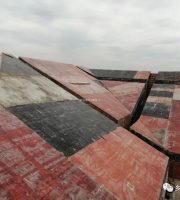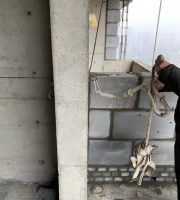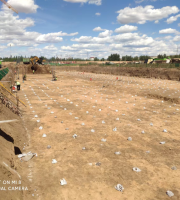6.
Investigate the topography, landform, geology, hydrology, underground buried objects, aboveground obstacles, adjacent buildings, water and electricity supply, transportation roads, etc.
If tombs, soil holes, tunnels and waste wells are found, the foundation shall be locally treated.
8.
Two or three shifts are adopted.
Build temporary facilities necessary for foundation pit construction, such as water supply, power supply, drainage and construction facilities, and complete them according to the general construction layout.
Excavate large-area earthwork with large length and width at one time, and shovel, transport, unload and fill with scraper.
Pay attention to pit wall support during foundation pit excavation.
Reasonably formulate foundation pit earthwork excavation procedures.
9.
Study the excavation procedure and construction scheme.
5.
Excavate in layers, support first and then excavate.
Allocate vehicles and construction personnel and organize operation shifts.
3.
Study and review the drawings, review the foundation construction drawings, check the plane size and pit bottom elevation, and find out the relationship between the foundation plane and the surrounding buildings and underground facilities.
For the foundation pit with support, the position line of support shall also be determined.
2.
Earthwork excavation method: generally large opening excavation is adopted, which is divided into mechanical and manual excavation, and the combination of mechanical and manual excavation.
Large area foundation pit excavation shall be made into a 45 ° slope at the elevation change.
Mechanical excavation shall be selected.
Do a good job in surveying and setting out.
For the large and deep foundation, the hydraulic shovel with the capacity of 0.5 and 1.0 square bucket can be used for excavation, and the upper earthwork can also be carried out by scraper or bulldozer.
Which excavation method should be selected should be based on the engineering structure form, foundation pit depth, area, geological conditions, groundwater level and seepage, site width, surrounding buildings Comprehensive consideration shall be given to the size of ground load, mechanical equipment conditions, construction methods, construction period requirements and construction cost.
10.
Support and excavation coordination..
For the deep foundation pit with high groundwater level, reduce the groundwater to the required depth one week before excavation.
2、 Selection of earthwork excavation scheme 1.
The reverse excavation method is used.
Support, slope protection and dewatering schemes shall also be proposed for deep foundation pit excavation.
The deep foundation pit shall be excavated in 2-3 layers, and 10-15% ramps shall be built.
3.
For large-area and deep foundation pit, vertical shaft shall be drilled for blasting.
Deep foundation pit excavation machinery relay excavation and transportation, and the method of erecting sleepers after excavation, so that the excavator can drive out of the foundation pit..
Gray line, elevation and axis shall be rechecked, inspected and accepted.
2.
Do a good job of dewatering and drainage facilities.
Four supplies and one leveling, water, electricity, communication, road and site leveling.
3.
For the excavation of large-area foundation pit with small depth, bulldozer or loader shall be used to push and load the soil, and dump truck shall be used to transport the soil.
All soft soil layers, garbage and turf that are not suitable for filling shall be excavated.
Prepare machines and tools and construction personnel, excavators, bulldozers (or other earth moving machinery) and transport machines and tools to enter the excavation operation area for maintenance and commissioning.
1、 Earth excavation preparation 1.
4、 Mechanical excavation method of Foundation Pit 1.
5、 Precautions for foundation pit earthwork excavation 1.
9.
The excavation machinery shall be reasonably selected according to the foundation form, project scale, excavation depth, soil quality, groundwater, earthwork volume, transportation distance, site machinery and equipment conditions and construction period requirements.
2.
According to the internal control network (main control and benchmark) and the foundation plan, carry out the positioning and setting out of the foundation pit, and measure the position and elevation of the upper side line of the excavated foundation pit and the bottom side line of the foundation pit.
of the construction site.
3、 The earth excavation drawing draws the earth excavation drawing, which includes: mechanical excavation route, sequence, scope, elevation of each layer of the base, slope gradient, geometric dimension of the foundation pit, drainage ditch, location of water collecting well, support location, earth transportation road and stacking place of excavated earth, etc.
Pay attention to the preparation efficiency when selecting machinery.
Each section of foundation pit excavation machinery is equipped with corresponding machinery and operation shifts according to the size, depth, earthwork volume and other factors of the work site and the requirements of the construction period.
The slope of the foundation pit shall be determined according to the soil condition, site size, groundwater condition and the depth of the foundation pit.
Use existing buildings.
2.
First, the earth above the groundwater level is excavated with the front shovel excavator, and then the groundwater is excavated with the pull shovel or backhoe? The earth below shall be transported by dump truck.
Reserve the thickness of soil layer, and reserve 150-300mm thick soil layer at the bottom of foundation pit for manual excavation and trimming.
Reinforce or protect the original buildings, poles and towers nearby.
The blasting work is generally completed in advance when the site is leveled.
7.
Formulate multiple schemes and select them through comparison.
When digging in underground water, pull shovel can be used.
For the foundation pit with large excavation depth, when slope excavation is adopted, multi-stage platform should be set for layered excavation, and the width of each stage platform should not be less than 1.5m.
8.
Draw the earth excavation drawing 4.
Blasting in the foundation pit, drilling and blasting.
Layered excavation 2 Section excavation 3 Basin excavation 4 Central island excavation 4.
Remove the obstacles on the site and remove the ground and underground obstacles in the site, such as high-voltage lines, electric poles, aboveground and underground pipelines, cables, graves, trees, ditches, old houses, foundations, etc.
1.
Carry out underground tomb exploration.
Multiple blast holes, less charge, loose blasting in layers, slag removal in layers, each layer is about 1.2m thick.
Multi layer relay excavation 7.
The rock foundation pit excavation adopts the controlled blasting method to loosen the bedrock and blast it into fragments.
When undrained excavation is adopted for the deep groundwater level, different machines can also be used for excavation in layers.
Excavation shall be carried out in sections and layers.
If the operation surface is narrow, there is groundwater and the land humidity is high, the hydraulic backhoe excavator can be used to excavate and the dump truck can be used to transport the soil.
10.
Various technical requirements.
In the loess area, Luoyang shovel shall be used to explore the foundation at the position according to the design requirements.
5.
6.
3.
At the same time, the influence of the construction environment, the ground load of adjacent roads and slopes shall be considered.
According to whether the excavation slope is graded or not: the slope excavation is provided with support, and the excavation slope is combined with support.
Earth excavation methods earth excavation methods include layered excavation, segmented excavation, basin excavation, central island excavation, etc., which are selected according to the size of foundation pit area, excavation depth, support structure form, environmental conditions and other factors.





